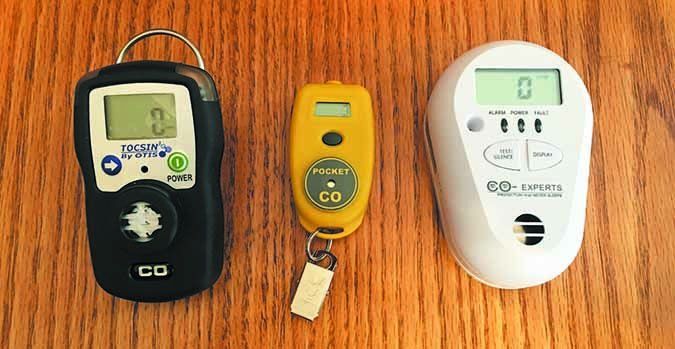We’ll say it up front—in the great scheme of things, your risk of getting hurt or killed in an aircraft accident due to carbon monoxide poisoning is on the low end of the spectrum. From what we can tell, it’s a little below that of having a midair collision. Nevertheless, it’s not zero, our airplanes are aging and maintenance isn’t perfect, so if you fly in an area where you use your heater during at least half the year, we think it’s wise to have a detector in the airplane that will alert you to even very low levels of CO.
CO in the cockpit usually arrives through the heater ducting due to a crack in the muffler. Cracks don’t heal themselves. Worse, they can get dramatically larger on short notice and deliver a massive quantity of toxic, odorless, colorless gas. Being able to detect low levels of CO means being able to fix a problem before it becomes severe.
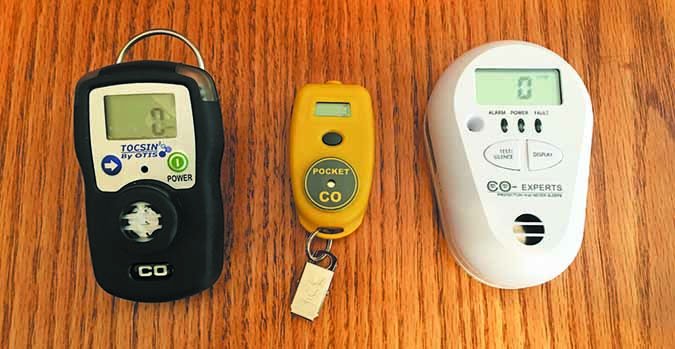
In our experience, a portable CO detector that reads out low levels of CO is the right tool for the job. It’s not as expensive as a panel mount, often more capable and it can be used to sniff around the cabin for localized CO concentrations. We found a problem in the baggage area of a Cessna 150 some years ago with a portable CO detector. Exhaust gases were entering the rear fuselage and flowing forward into the cabin past a poorly sealing baggage curtain.
We surveyed the most popular portable CO detectors that we consider suitable for general aviation use as we’ll as the old-familiar chemical spot detectors. Bottom line: We consider all of the electronic units to be satisfactory—but like the CO Experts Model 2016 for its sensitivity, followed by the Tocsin unit. We’re not crazy about the chemical spot devices due to lack of low-level information—although they will change color when exposed to high levels of CO if you replace them when the makers say to do so.
We spot checked the electronic portables and spot units by placing them in a plastic bag and exposing them to a CO source. All worked as advertised. Here are the units we surveyed, in no particular order.
Tocsin
Offered by Sporty’s, the $169.95 Tocsin OI-315 CO Cockpit Monitor by Otis Instruments Inc. is a CO detector that can be mounted almost anywhere in an aircraft. It has a belt clip, mounting ring and hook and loop tape so it can be clipped to a map pocket, hung from a knob or hook or attached more permanently as desired. It features a real-time CO concentration level readout on an LED screen starting at 1 PPM and running through 500 PPM—a more than adequate range, in our opinion.
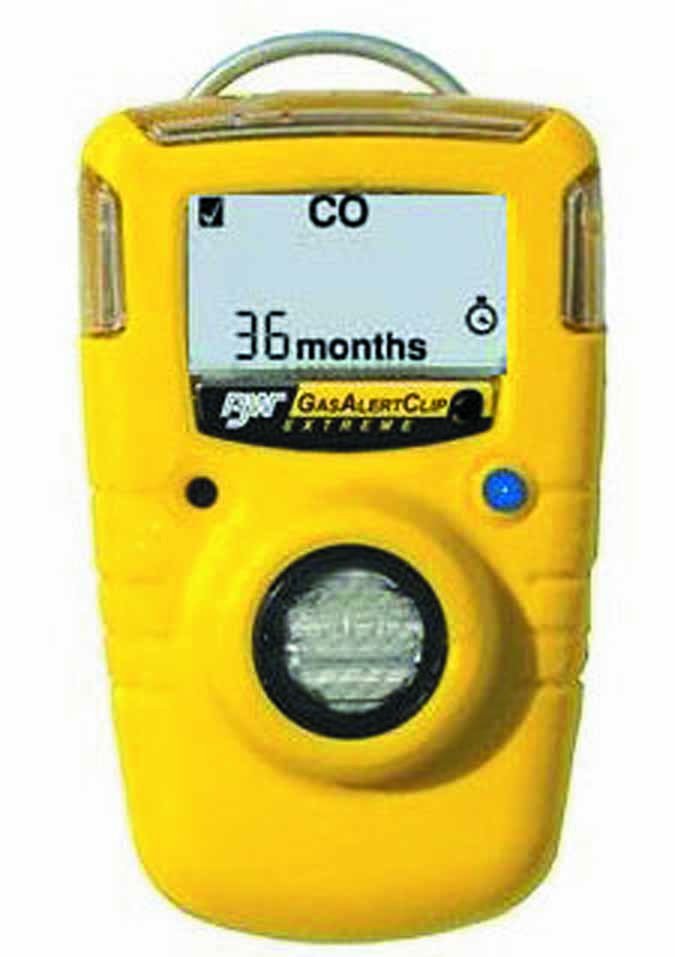
The Tocsin first alarms at 35 PPM with a flashing LED light, a 90 dB Piezo horn and the unit vibrates. There is no time delay between the unit sensing a 35 PPM concentration and the alarm—a good feature, in our opinion. In our opinion, 35 PPM is the maximum level for a first alarm. The Tocsin’s first alarm can be silenced. If CO concentration continues to increase, the Tocsin’s high-level alarm activates immediately on sensing a 100-PPM level. The high-level alarm cannot be silenced except by moving the unit to a fresh air location and shutting it off. We think that can be a significant distraction.
The alarm levels can be customized by the user, although the manufacturer cautions against doing so. The unit also has time and date features and a data logger. The Tocsin is rated for temperatures from -20 degrees C to 50 degrees C.
We were not impressed with the manual that came with the unit. It was not easy to understand and a number of important terms were not defined—the writers seemed to assume that a user would understand the jargon. The sensor is rated for two years. Otis Instruments recommends returning the unit to its service department after two years for sensor element and battery replacement, calibration and complete unit inspection. The cost is $85.
CO Experts
CO Experts has been making what we consider to be the most sophisticated low-level CO detectors for years, and it’s been making them progressively smaller with more features. Originally designed for household use, the company eventually recognized the value of low-level detection in aircraft and added some features of value to pilots. With an 85 dB Piezo alarm, there is no concern about missing a warning even if the unit’s not in sight. We’ve used various models over the years and found that they were sensitive enough that we got an alarm one time while waiting to depart from AirVenture in a twin because the ambient wind was blowing exhaust from the left engine into the cockpit through the pilot’s vent window.
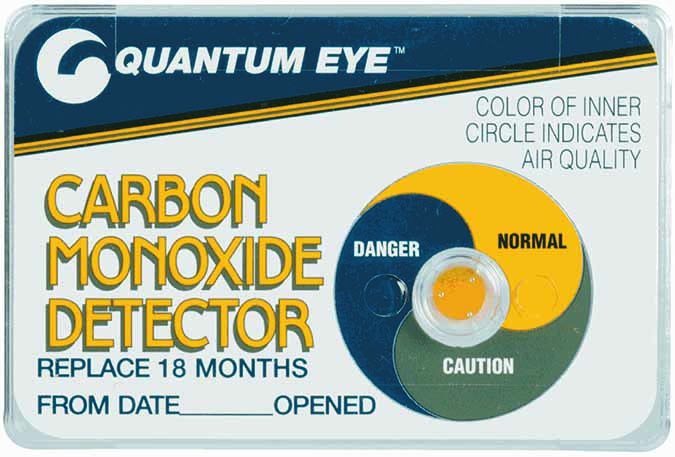
Available through Aeromedix for $199, the newest in the CO Experts line is the Model 2016. It displays CO starting at 1 PPM and makes its first alert immediately at 7 PPM. It has a graduated series of alarms as the CO concentration rises—there is no time delay between hitting a concentration level and the alarm sounding. It has a silence feature allowing the user to shut off the alarm temporarily—the length of time the alarm will remain silent decreases at higher CO concentration levels and the alarm will sound again after silencing if the CO level increases.
The Model 2016 also has an alarm memory and recall functions to display exposure history as we’ll as the approximate percentage of oxygen that would have displaced by CO in the body of someone who experienced that exposure. We feel that is valuable for an inflight exposure event, especially as it will help determine if there is a need for treatment and provides valuable information for medical personnel.

The unit has an expected life of five years and includes a failsafe monitoring system that warns of a detector failure, low battery and impending end of life of the unit.
How Carbon Monoxide Kills
Carbon monoxide (CO) is a product of incomplete combustion of fossil fuels. In a piston-engine airplane, the invisible, odorless gas is emitted in high concentrations when the fuel mixture is richer than peak EGT—one rarely discussed benefit of operating lean of peak EGT is a low level of CO emissions.
When you inhale, oxygen reaching your lungs combines with the hemoglobin in your red blood cells to form oxyhemoglobin. The oxygen is transported throughout your body by your arteries and capillaries and then disassociates from the blood to oxygenate the cells of your tissues and organs. The deoxygenated hemoglobin returns through your veins to your lungs to reload.
Once carbon monoxide gets into your lungs it becomes the schoolyard bully on steroids—it combines with your hemoglobin to form carboxyhemoglobin (COHb) with a bond that is 200 times stronger than oxygen’s bond with hemoglobin. CO takes over, effectively putting your hemoglobin out of commission and depriving your body of oxygen. The hyper-strong COHb bond means that even tiny concentrations of CO can kill you through slow poisoning over a period of several hours. That bond explains why it takes several hours to eliminate CO from your body.
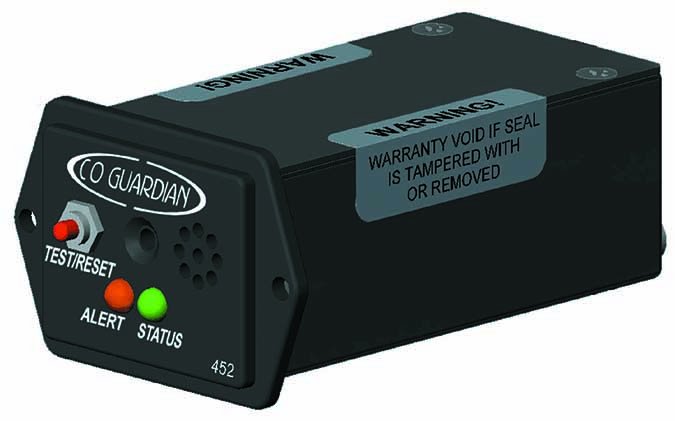
COHb has a half-life of more than five hours for someone breathing fresh air. If you manage to put your airplane on the ground and stagger out of the cockpit with a COHb saturation of 50 percent, it will take at least five hours for it to drop to 25 percent. If you are hustled off to the hospital for pure oxygen treatment (mask or ventilator), the half-life of COHb will drop to on the order of two hours. In extreme cases, the patient is put into a hyperbaric chamber with pure oxygen under three atmospheres where the COHb half-life can be cut to a half hour. That still means a significant amount of time to get rid of CO in the body. It doesn’t just go away after you step out of the contaminated airplane.
The oxygen-deprivation function of CO poisoning makes it deadly because it attacks the most important parts of your body first—brain, nervous system, heart and lungs. The first symptoms are headache, fatigue, dizziness, vision problems, increased pulse and respiration rates and nausea. Sitting in the cockpit and continuing to breathe even low concentrations of CO means the danger continues to increase as the strong COHb bond causes the concentration in your blood to continue increasing.
In new airplanes, the FAA allows up to 50 PPM of CO in its prescribed test. OSHA originally allowed 35 PPM in the workplace but upped it to 50. The EPA calls for a health alert if outdoor concentrations reach 9 PPM for eight hours or 35 PPM for one hour.

We note that low concentrations of CO in the bloodstream have a higher degree of hazard to pilots because they are exacerbated by hypoxia—a 10 percent COHb concentration is no big deal on the ground (normal for a smoker), but at 10,000 feet it significantly degrades night vision and judgment.
The most common way for CO to get into the cockpit is through the heating system due to cracks in the muffler. We think any in-flight CO concentration of 10 PPM should be grounds for finding the source and eliminating it. If it gets to 35 PPM, we recommend that you go on oxygen if you have it and land as soon as is practical.
Pocket CO
We like the idea of a CO detector that we routinely carry with us—maybe on a keychain. For $124.50 from Aeromedix and $132.75 from Aircraft Spruce, the Pocket CO 300 is just that—a keychain CO detector. It displays the CO concentration, but does not alarm until it hits 50 PPM, a shortcoming, in our opinion. The alarm sounds at 82 dB, flashes an LED light and vibrates with increasing frequency at thresholds of 50, 125 and 400 PPM. There is no time delay—it alarms upon reaching a concentration threshold. The unit can be turned on to stay on for 12 hours or continuously, at the user’s discretion. Our initial impression was that a “keychain” device couldn’t be very sophisticated. We were wrong. It tracks total exposure to CO, eight-hour time-averaged exposure, measured maximum exposure and when it occurred.
The Pocket CO will also fire its alarms if the temperature is under 0 degrees C or above 50 degrees C or an internal sensor malfunctions. It is powered by a coin cell battery that can be replaced by the user. The manufacturer recommends that the unit be turned off when actually in a person’s pocket—it needs to be open to the surrounding environment.
GasAlertClip
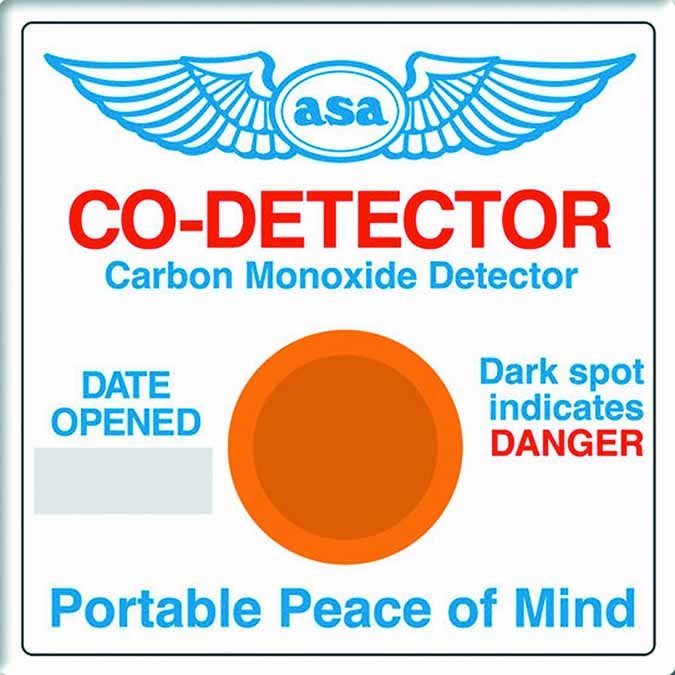
Advertised as the world’s most popular, zero-maintenance CO detector, the GasAlertClip Extreme is available in two- and three-year versions from Aircraft Spruce. The prices are $159.95 and $272.95, respectively. The target customers for the GasAlertClip are workers in facilities where there is risk of CO exposure and who need a unit that requires minimal training and simple operation. That does a good job of describing the need for an easy-to-use CO detector in a general aviation airplane. It is not designed to be maintained or to have its sensor replaced—use it for the design life and throw it away.
With its industrial-use design, the GasAlertClip is a rugged unit—it has a “concussion-proof housing”—that has a belt clip and loop that allow it to be hung anywhere that is convenient in the cockpit.
The CO sensor has a range of 0-300 PPM. The low-level alarm is set at 35 PPM and triggers a 95 dB tone, flashing LED light and vibrates the case. The high-level alarm sounds at 200 PPM. The LED display reads out CO concentration as we’ll as time remaining on the sensor. There is a data logger that records exposures. The exposure data can be downloaded.
We like the GasAlertClip from a simplicity standpoint; however, having to buy a new one every two or three years makes sense when they are bought in bulk for factory or maintenance workers, and it’s time-consuming to collect units and send them out for maintenance. However, for a user who is only going to buy one, such as for a general aviation pilot, we think it would be better to be able to send the unit in for refurb.
Panel-Mounted CO Detectors
While we lean toward the convenience of portable CO detectors and the ability to use them to sniff throughout the cabin, they run the risk of being forgotten or lost, making panel-mounted units attractive.
The big dog in the world of panel-mounted CO detectors is Guardian Avionics, which makes five detectors for the dash and two remote-mount units. They differ in size and features offered, with one including a pulse oximeter—it should be noted that a pulse oximeter does not detect CO presence in the blood. We surveyed three Guardian units.
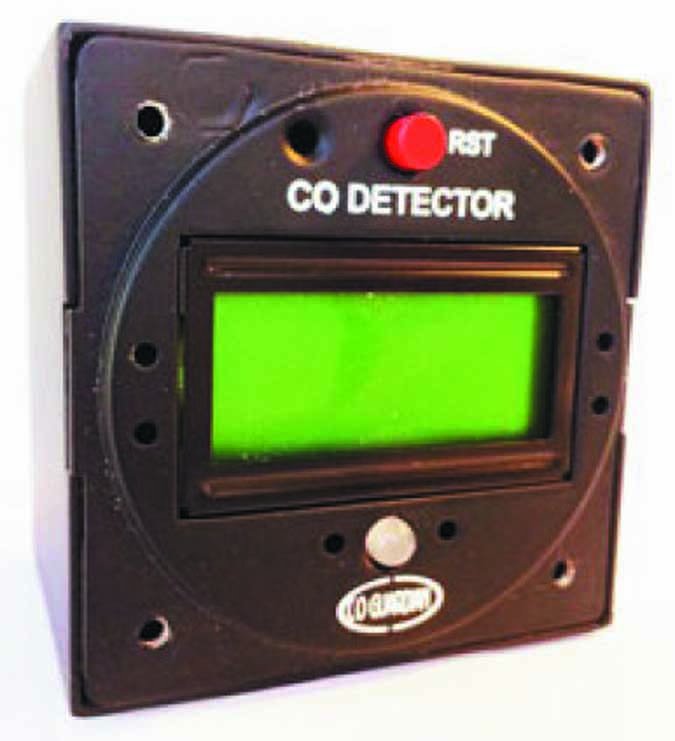
At $499 plus a two- to four-hour installation, the Aero 452-101 will fit into a 2.25 by 1.5 inch panel opening and weighs 3.5 ounces. It provides CO detection and a cabin pressure warning and the ability to display the information on a long list of PFDs, MFDs and engine monitors. There is no display on the unit itself.
The 452-101 will operate on 14 or 28 volts and has an internal fan to improve sensing. When the CO level reaches 50 PPM and remains for a three- to five-minute span it alarms with a flashing amber LED light and an 85 dB tone. If the CO level reaches 90 PPM it alarms immediately with a flashing red LED and an 85 dB tone. When CO levels are below 50 PPM, a green LED shines continuously.
We are uncomfortable with a unit that does not provide information on low levels of CO as we recommend that if 10 PPM is detected, the airplane should go into the shop and the cause fixed and that if 35 PPM is reached in flight that the pilot should go on oxygen and the flight terminated.
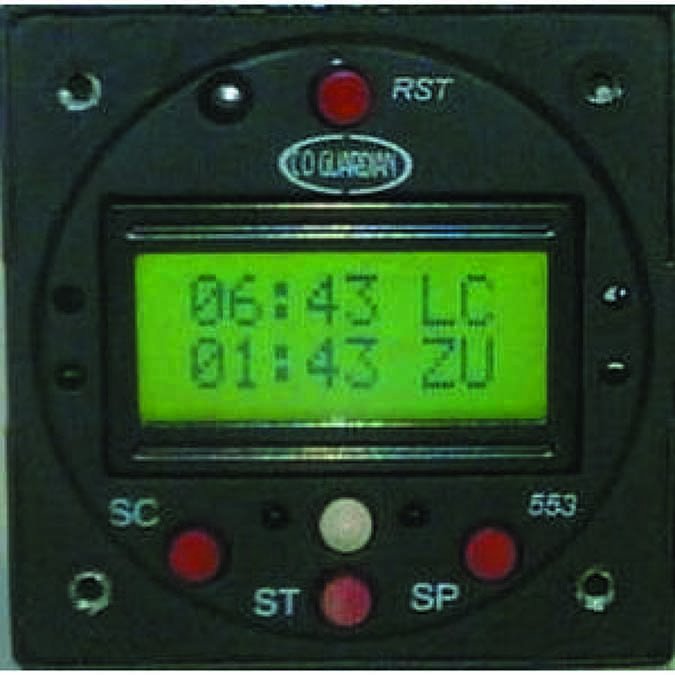
The Aero 551 CO detector is Guardian’s most sophisticated detector. At $599, it displays CO concentrations from 10 to 999 PPM and fits into a standard 2.25 inch round instrument cutout. While we like the continuous display of CO levels—that may be caught in an instrument scan—the first alarm does not sound until the level reaches 75 PPM and remains there for five minutes. If it reaches 300 PPM, it will alarm within one minute.
The $699 Aero 553 retains the functionality of the 551 and is designed to physically replace the panel clock as it has a clock function. In addition it has features that include a flight timer, stopwatch, inside and outside air temperature, battery voltage, cabin altitude and density altitude features on an LED display. It will also display its indications and alerts on a number of third-party avionics products.
The CO detector detects and displays CO levels from 30 PPM to 999 PPM and alarms if the level exceeds 50-70 PPM for five minutes or above 300 PPM for one minute.
Life span of the Aero units is five to seven years. We like that the Aero 551 displays CO levels as low as 10 PPM. Nevertheless, we think that’s a bare minimum requirement for any detector. Because of the insidious nature of CO poisoning and the risk of exposure to under 50 PPM over the course of a flight of a few hours, we think all of the detectors should alarm at a level below 50 PPM.
Chemical Spot Detectors
Stick-on chemical CO detectors seem to have been around general aviation since it was a lieutenant. They are stick-on pieces of cardboard or plastic that contain a circular chemical patch that is said to turn dark in the presence of CO. We found them in prices ranging from $4.50 to $9.95 and marketed under various names including ASA CO-Detector, Quantum Eye Long Life Carbon Monoxide Detector and Sporty’s Pilot Shop Carbon Monoxide Detector.
The spot detectors are the butt of many jokes in aviation as, despite the fact most are only good for 90 days—the Quantum Eye Long Life unit claims 18 months—they tend to get stuck to an instrument panel and left there indefinitely. We also hear pilots express questions as to what color is “dark.”
Most of the spot detectors have a place for the installer to write in the date the unit was opened. That’s all we’ll and good—most don’t have anything printed on it that tells an observer the life of the unit. In our opinion, as with the sticker you get in your car after an oil change, the unit should say when it’s time to yank it and put in another. We note that the Quantum Eye passes this test as the instructions on its face call for replacing it 18 months after the date opened—and there’s space for writing in the date opened.
There is good news—Aviation Consumer‘s testing of the spot detectors a few years back showed that if they were within their expiration date, they would turn dark in the presence of a CO level of 90 PPM. They don’t alarm, just change color, so a pilot has got to include the spot detector in a regular instrument scan and he or she has to make a decision as to whether it’s changed color. On that note, we like the Quantum Eye unit because it has a color-coded guide showing normal, caution and danger colors adjacent to the chemical spot.
Spot detectors do not show low levels of CO—something that disqualifies them, in our opinion, from being serious devices. Nevertheless, they are better than nothing.
If your decision is to use one of the spot detectors, we recommend only the Quantum Eye because of its color coding and clear instructions about replacement. We found them for $9.95 at Aircraft Spruce.
Residential Detectors
There are dozens of household CO detectors, some with prices not much above those of the chemical spot detectors. We do not recommend any of the residential detectors as most follow Underwriters Laboratories spec UL-2034, which requires a time delay before the unit will alarm once a given level of CO is present. That’s to cut down on calls to 911 for false alarms. Under the UL spec, if the unit has a digital readout, it cannot show CO concentrations below 30 PPM. The unit will not sound an alarm until CO reaches 70 PPM and remains there for four hours. At a concentration as high as 400 PPM, the unit will generally not alarm for 15 minutes.
Given the effect of flight at altitude in combination with low-level CO poisoning, we think it’s quite likely a pilot would be incapacitated we’ll before a household detector would alarm in flight.
Conclusion
Because of its sensitivity, useful life and low-level alarms, our favorite is the CO Experts Model 2016. It’s the most expensive unit, but it lasts the longest, so it’s not the most expensive in service. The Tocsin came second in line with the Pocket CO a close third.
If the budget just won’t cover an electronic unit, then at least get a Quantum Eye, put it where you can see it easily and make sure you replace it every 18 months.

